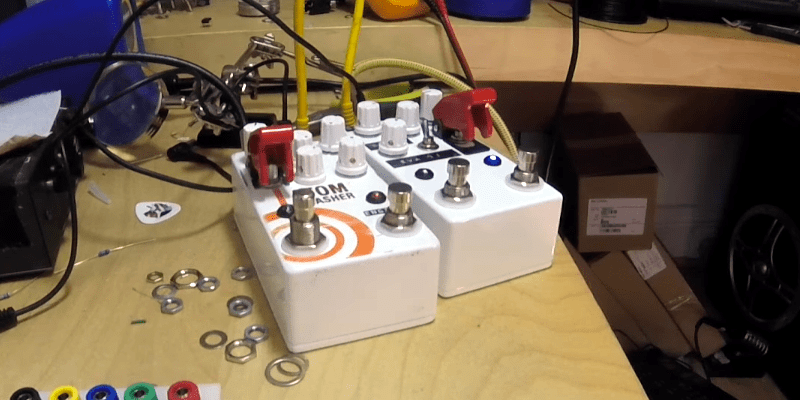[Alex Lynham] has been creating digital guitar pedals for a while and after releasing the Atom Smasher, a glitchy lo-fi digital delay pedal, he had people start asking him how he designed digital effects pedals rather than analog effects. In fact, he had enough interest, that he wrote an article on it.
The article starts with some background on [Alex], the pedals he’s built and why he chose not to work on pedals full-time. Eventually, the article gets to the how [Alex] designed the Atom Smasher. He starts by describing the chip he used, the same one that many hobbyists, as well as commercial builders, use for delay based effects – the SpinSemi FV-1.
The FV-1 is a SMD chip used for digital delays and other effects that require a delay line – reverbs, choruses, flangers, etc. It’s programmed with an assembly-style language called SpinASM. [Alex] goes over some of the tools and references he used when designing for the pedal. He also has a list of tips for would-be effect pedal designers which work whether you’re designing digital or analogue effects.
[Alex] ends his article saying that, in the future, he might make the schematic and code available, but for the moment he’s not. The FV-1 is an interesting chip, and [Alex]’s article gives a nice high-level look at its features and how to develop for it. For some interesting guitar pedal related articles, check out this one using effects pedals to get better audio in your car, and here’s one about playing with DSP and designing a pedal with it.
















Damn interesting little Chip!
I’d like to build a very simple clean couple seconds looping delay effect on the cheap without having to order samples of rare chips or source some obsolete parts.
Where to start?
google pt2399
It only has milliseconds of delay, up to about 1/3 of a second, and unacceptably high harmonic distortion.
I mean, I don’t mind distortion, but since it’s a bit bucket device and I’d have to run it really slow to get the delay, it’s going to just sound like crap.
I think you mean bucket brigade :). The PT2399 is actually a digital sampling device, although you can get the BBD-LPF effect via the feedback circuit design. But, yes, they’re not so hi-fi at greater delay times. You can technically get above the 31.3 ms delay time in the data sheet, but your %THD increases accordingly. Have you checked out the Teensy DSP applications? Might be up your alley.
https://www.pjrc.com/teensy/td_libs_Audio.html
mmm, distortion!
I was considering trying to make a diskette spin around as an endless tape, but I have no idea how to construct the magnetic heads.
Maybe you could just start with a actual floppy disk then? We’ve seen them used to store analog loops before.
Alternatively, actual literal tape delays are pretty straightforward.
Musically and artistically it would be more efficient and cost effective to buy the cheapest electric guitar on eBay, a thirty foot lead, plug it in then drop it down a flight of stairs. To get the slower more thoughtful phrases, just drag it back up by its lead.
I like the cut of your jib.
A number of classic black metal bands achieved their sound through cheap, expedient methods. Recording Burzum’s Filosofem involved a guitar plugged into a $20 boom box instead of an amp, and screaming into headphones used as a microphone.
Was a little disappointed there was no atoms being smashed in this article.
Exactly. I was looking for the “Do Not Try This At Home” warning.
I think there’s a lot of vanity in producing your own pedal to do something PureData or Max/MSP could do without breaking a sweat or requiring yet more electronic junk to be produced for every different effect you want.